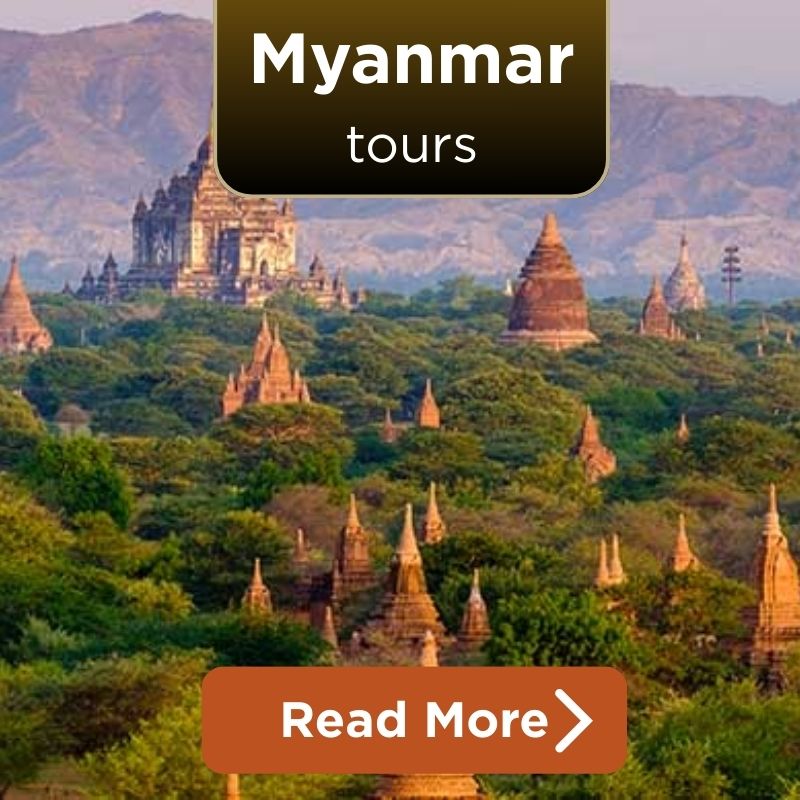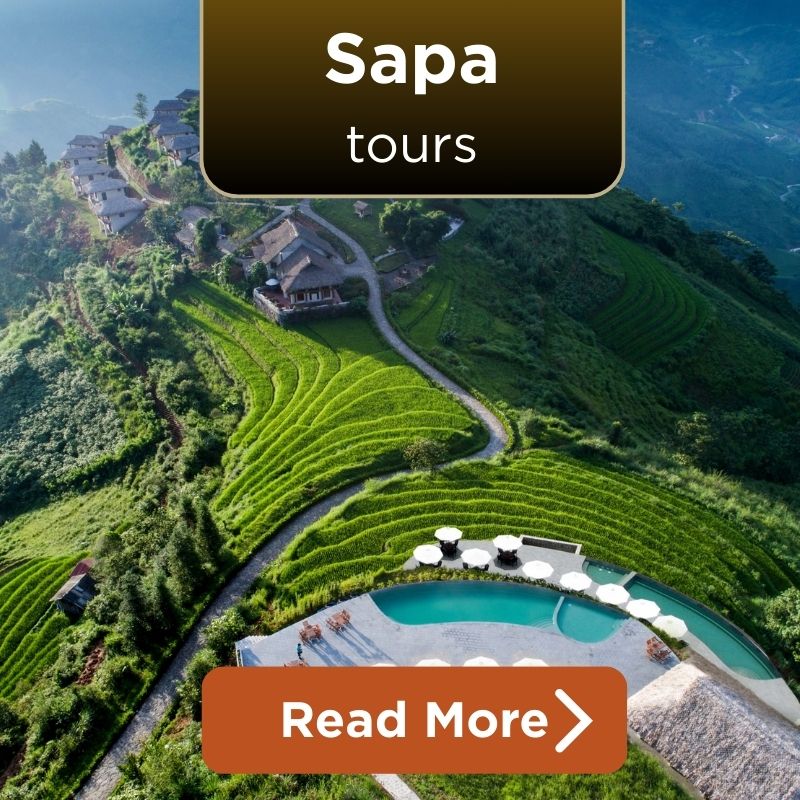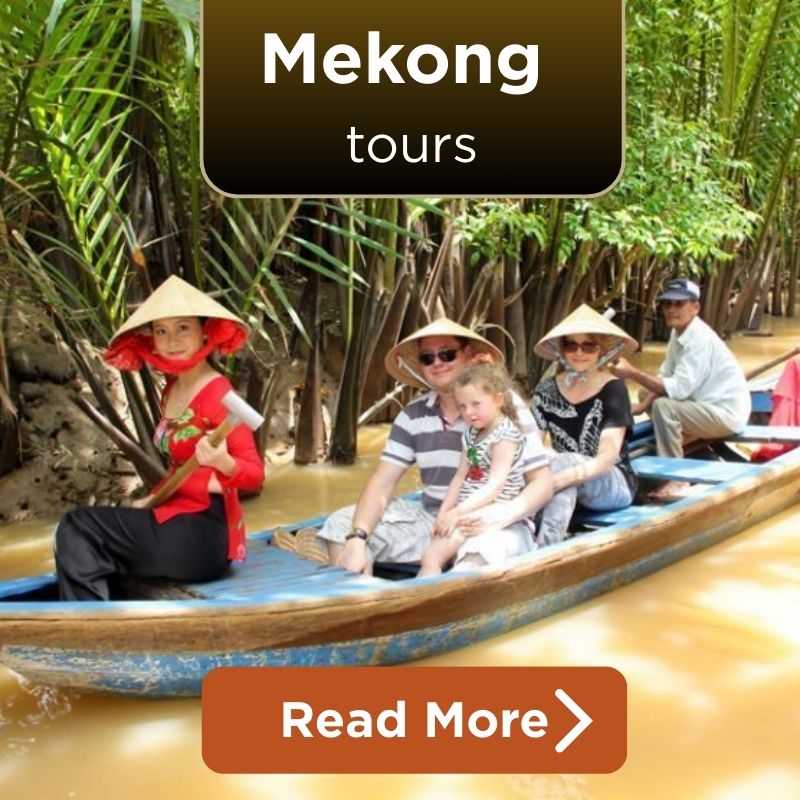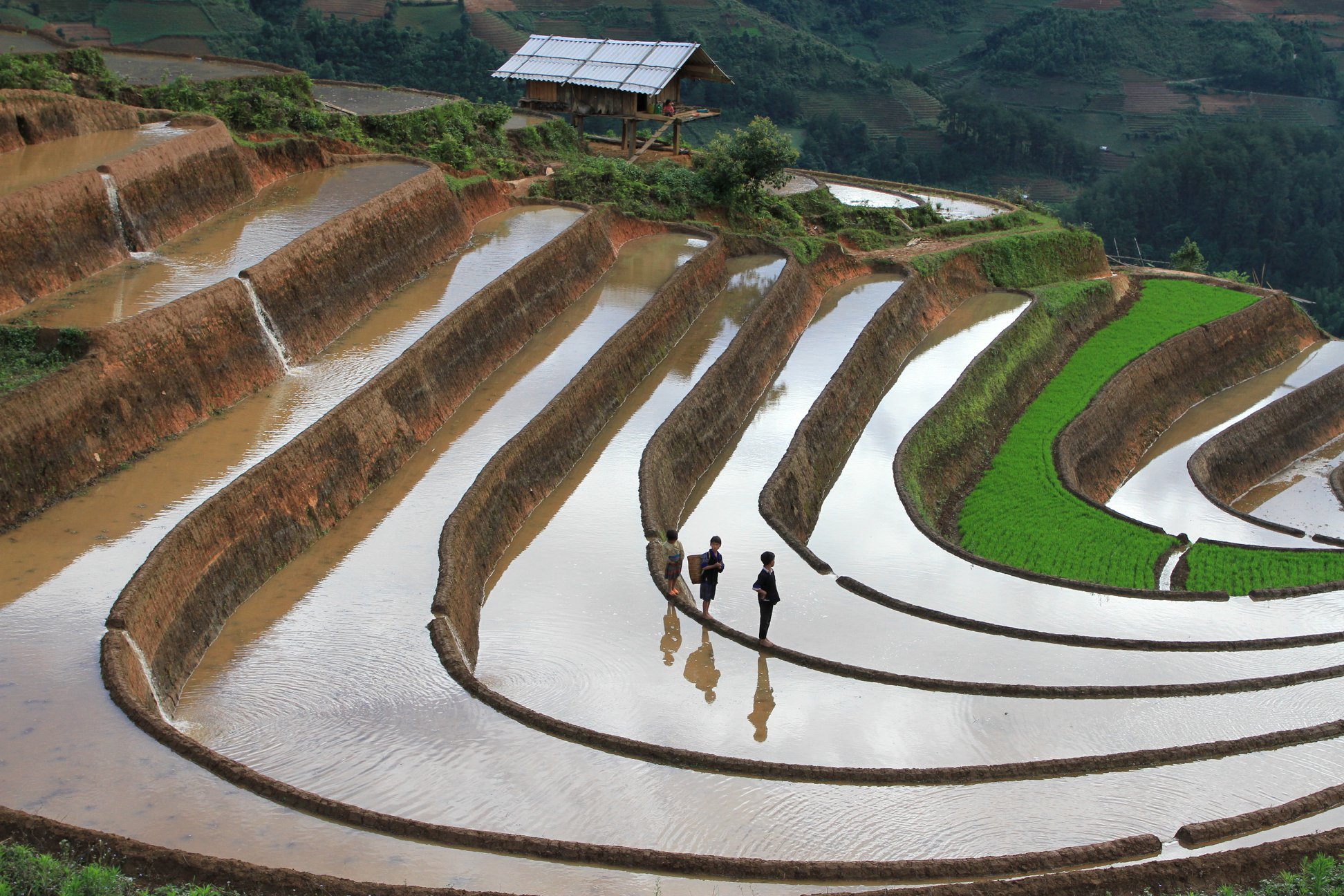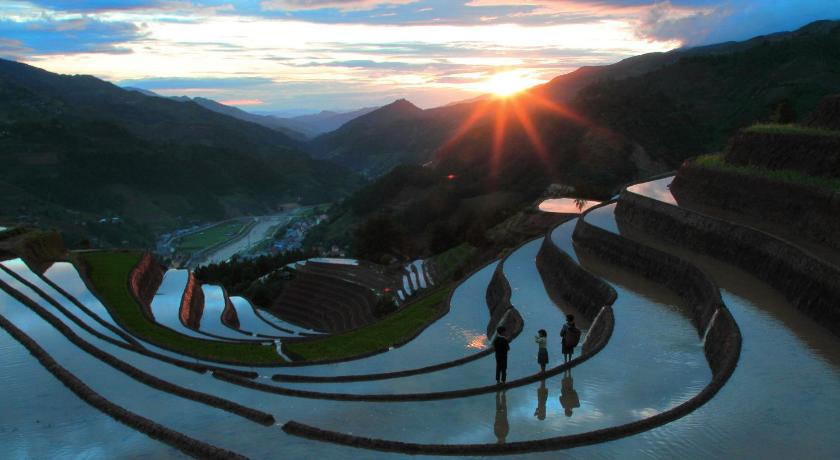Located in the Northwest of Vietnam, Mu Cang Chai is widely known to host humbling rice-terraced fields and attracts visitors from across continents. Beyond its magnificent landscapes, it houses the Hmong Community, one of the local ethnic groups with very immense richness in culture and interesting traditions. It is the uniqueness of the Hmong when touring Mu Cang Chai, with their very special cultural practices and traditional festivals, and strong-connected relationship with nature.
Traditional Clothing and Textiles of The uniqueness of the Hmong when touring Mu Cang Chai

Traditional Clothing
Traditional clothing represents artistic and cultural pride for the Hmong people. The methods used by Hmong women to create complex textiles have been passed down through generations. The steps to make their traditional clothing include natural indigo dyeing, detailed embroidery, and appliqué work. Every cloth is a story by itself; the patterns and symbols are culturally significant.
Hmong clothes do not only serve as attire but are also symbolic of identity and status within a community. For instance, the Hmong Si, meaning Red Hmong, wear red headscarves and richly embroidered skirts, while the Hmong Hoa, otherwise known as the Flower Hmong, are recognized for brightly colored clothing with elaborate patterns. Such dedication to preserving these traditional crafts befits the uniqueness of the Hmong when touring Mu Cang Chai, whereby one has a chance to witness firsthand the series of p
Culinary Traditions of The uniqueness of the Hmong when touring Mu Cang Chai
Food is an essential aspect of experiencing Hmong culinary traditions. Hmong Cuisine for Mu Cang Chai is quite simple and relies on supplies collected from the natural environment. A typical ingredient would be the use of mèn mén, a type of cornmeal, which is steamed and served with side dishes. Another yummy dish among them is thắng cố, the traditional thick horse stew with numerous herbs, speaking much to Hmong resourcefulness and their being connected to the elements of nature.
The Hmong also use such a time to come together and feast on their harvested produce, the traditional dishes being passed on to one another with great gestures. There is no better opportunity to know what Hmong tastes are all about than this platform that will gather visitors to explain why food is important in their culture. The uniqueness of the Hmong when touring Mu Cang Chai is much enriched by the culinary experience that one goes through in offering a gaze into the traditional way of life.
Handicrafts and Art

Traditional costumes of the Hmong people
Hmong people are very fond of creativity and cultural heritage, as evident in their handicrafts. From silver jewelry to bamboo weaving, Hmong artisans create items from everyday practical things to pure decorations. This often finds expression at the local markets and festivals, where visitors can buy unique souvenirs to support the local economy.
Jewelry, particularly the ones made of silver, enjoys a predominant place in Hmong culture and is worn by them during festive and special occasions. Intricate designs and fine workmanship are characteristic of the best features of the Hmong—meticulousness and creativity. Bamboo weaving, for its part, can turn out basketry, mats, household implements, and other items signifying resourcefulness and closeness to nature—two salient features of the Hmong. Participation in this craft will help one better fathom the uniqueness of the Hmong when touring Mu Cang Chai.
Social Structure and Community Life
The Hmong social structure is deeply embedded in several generations’ worth of traditions and customs. All Hmong belong to a particular clan with its own rules and rituals. Elders receive very high regard among these communities because they are custodians of cultural knowledge, and arbiters in social matters.
Family is the basic unit in the Hmong, usually including extended families who often stay together or near each other. Cultural values and practices are therefore easily passed on from generation to generation in this close structure. Some significant occasions, including traditional ceremonies associated with birth, marriage, and death, seal social bonding and confirm their identity with their culture. Understanding this social fabric is the key to appreciating the uniqueness of the Hmong when touring Mu Cang Chai.
Interaction with Nature in The uniqueness of the Hmong when touring Mu Cang Chai
The Hmong’s relationship with nature is part of their culture. Being native to the mountainous regions of Mu Cang Chai, sustainable agriculture has become established among the Hmong people in harmony with the environment. Terraced rice farming is an example of creativity in the face of steep ground and a shortage of cultivatable lands.
Production techniques of the Hmong not only involve practicality but also culture. Rituals and feasts often align with these agricultural cycles, thanking nature and spirits whom they believe protect cultivated crops from any harm. This deep connection with nature is manifest in their everyday life and gives tourists a special perspective. Directly experiencing these practices makes a visitor realize what differentiates the Hmong when touring Mu Cang Chai, as it gives insight into sustainable ways of living.
Challenges and Preservation Efforts

Gau Tao Festival
For such a culturally rich community, Mu Cang Chai‘s Hmong face so many challenges. Gradual wearing away at the traditions and values of the past, with modernization and outside influences, is also prevalent. Added to that are changing economics and environmental stressors piling pressure on traditionalist ways of life conducted in the guise of culture.
The Hmong culture, however, is still preserved and promoted. Local and national initiatives have been undertaken in documenting and celebrating such traditions of the Hmong through festivals, museums, and cultural centers. Such conservation works rely on tourism for economic sustenance and increasing awareness regarding cultural heritage. Through such activities, visitors can help make the Hmong culture sustainable and experience the uniqueness of the Hmong when touring Mu Cang Chai.
Traditional Festivals and Celebrations
One of the most engaging characteristics of the uniqueness of the Hmong when touring Mu Cang Chai would be their vibrant festivals and celebrations, telling much about their rich heritage culture. The Gau Tao Festival and New Rice Celebration have greater cultural values and go along with very elaborate rituals.
The Gau Tao Festival usually takes place in spring and serves as the necessary time to express the wishes of the Hmong people for good health, prosperity, and fertility. A festival lasting several days is portrayed by a variety of communal activities. One of the main features of such a celebration is a tall bamboo pole that is erected in front of communal houses, around which all rituals and other performances are performed. Men and women don elaborate traditional costumes with intricate embroidery, and bright colors, and show the vividness of the soul of the festival. There is music along with dancing as part of the activities; in fact, one can never miss the sound created by a specific kind of reed pipe, the khèn, to which one gets accustomed during the festival. Besides music, there are games and singing competitions that come along with feasting to make it all merry and interactive.
Equally significant is the New Rice Celebration, which marks the end of the harvest season. It’s a very emotional ceremony in appreciation to their ancestors and gods for providing good harvests. The rituals include offering the first part of the newly harvested rice to the spirits as an act of showing respect and thankfulness. After this act, communal feasts would follow, in which families and friends would come together to share traditional dishes, strengthening social bonds and community life even further. Visitors at this time could witness and participate in these rituals to gain insight into the depth of the agricultural practices of the Hmong, their affinity to the land, and other cultural traits food possesses.
Music and Dance
Music and dance are very significant features of Hmong cultural identity, for they manifest artistry and historical narration. Traditional forms of music and dance among the Hmong people are full of symbols and very close to life and spiritual beliefs.
There are a lot of different traditional instruments utilized by the Hmong; probably among the most iconic is the Khèn. Such a kind of reed pipe is hauntingly beautiful, both melodic and rhythmic. The instrument finds its use during the festivals but also in everyday life, often covering songs that describe love, nature, or historical events. Another main instrument is the đàn môi, or mouth harp, which produces a distinctive twang; it is often played in small settings and solitude.
Dance, however, is even a far more energetic rendition of Hmong culture. Traditional Hmong dances are done during festivals and important ceremonies, reflecting only themes found in nature, community, and spiritual beliefs. Thus, this may be characterized by complicated steps and graceful movements done in traditional costumes. In colorful attire, the dancers harmoniously flow to the music, creating a spectacle that appeals visually and auditorily to audiences.
It means that music and dance in Hmong culture are not merely a form of entertainment but a way through which cultural values and stories are preserved and passed on. During large festivals like Gầu Tào Festival, these attractions take center stage, making both locals and visitors feel a great sense of richness in culture from the Hmong. The communal feature of such performances instills a feeling of togetherness and identity with the people.
Traditional Clothing and Textiles of The uniqueness of the Hmong when touring Mu Cang Chai
Hmong traditional clothing mirrors their rich cultural identity, where they have different styles for each subgroup within the Hmong community. Hmong Hoa, also known as Flower Hmong, are famous because of their bright and multicolored clothes, with intricate embroidery and appliqué. Ladies are dressed in pleated skirts, brightly embroidered blouses, and adorned with headscarves carrying elaborate patterns. The Hmong Si (Red Hmong) are easily recognizable from their red headdress and richly embroidered clothes. Their sundry elaborated blinded designs are trappings both symbolic and beautifully pleasing in appearance.
The creation of these traditional textiles requires much work and artistic mastery. It starts with harvesting hemp, soaking it, and then spinning it into threads that will be naturally colored later with indigo. This process involves great skill and patience to dye this deep rich blue characteristic of Hmong vegetables. The cloth is then dyed and intricately embroidered with colored threads to create detailed patterns, often telling some story or signifying a cultural symbol. Sometimes appliqué work is added—meshing pieces of fabric onto the base material in yet another level of complication and beauty added to the garments.
Culinary Traditions

Thang Co
Looking to sample traditional Hmong cuisine is a must the uniqueness of the Hmong when touring Mu Cang Chai. Most dishes in their foods are simple and manifest freshness. Mèn mén, a staple food in the diet of the Hmongs, is cornmeal steamed to perfection, often served with side dishes. This recipe reflects the ingenuity and resourcefulness of the Hmong people, as corn is an aggressive crop that grows well in mountainous Mu Cang Chai.
Another specialty is thang co, a traditional stew of horsemeat cooked with many herbs and spices. This local dish was prepared during communal gatherings and festivals, which were then enjoyed by large groups of people. The process of preparing thang co is one in which the community comes together to cook it, and therefore the social bonds will be reinforced.
Conclusion
The uniqueness of the Hmong when touring Mu Cang Chai was very elaborately illustrated through vibrant festivals, colorful textiles, enchanting music and dance, and rich culinary traditions. Through these cultural practices, visitors will be able not only to gain a deeper understanding of how the Hmong live their lives but also witness that they are resilient and creative. Such traditions need to be preserved at all costs to retain the cultural identity of the Hmong and then pass them on to subsequent generations so that they, too, may rejoice in this heritage. Don’t forget to regularly follow our Impress Travel for more interesting information about traveling to Mu Cang Chai and to book Mu Cang Chai tours at the best prices.









